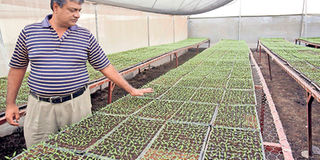Agronomist's notebook: A guide to growing seedlings in cocopeat

Sanjay Malde, who owns Plant Raisers in Isinya in one of his seedbeds in this past photo. Savvy farmers like him have turned to soilless media such the peat moss, cocopeat, pumice and sawdust, which is on the rise as farmers seek better seedlings. FILE PHOTO | NMG
What you need to know:
- Black nightshade grows naturally in the forest and is also likely to be affected by the same pest and diseases that affect tomatoes.
- Cocopeat must be treated first before use, what many farmers don’t do. Failure to treat the growing media normally results to poor germination percentage due to the scorching effect and antagonism, a condition whereby the plant is not able to take up nutrients due to the availability of another nutrient.
- The nutrients move from a region of low concentration to high concentration across a semi-permeable membrane hence the need to determine electrical conductivity.
- Once germination has taken place, the nutrition programme begins after two weeks since the media does not have nutrients, unlike soil.
Many crop farmers start the journey of growing various plants in seedbeds, where the performance of the seedlings determines the outcome of the final crop in the main field.
However, while a majority of farmers expect good results in seedbeds, this is not always the case as farmers go through challenges that include dealing with soil-borne diseases like fusarium wilt, which lead to poor seed germination.
Some farmers have gone an extra mile of getting soil from forests or virgin land for seedbed use, but this is not always a solution as the soil may also be infested by diseases.
Black nightshade grows naturally in the forest and is also likely to be affected by the same pest and diseases that affect tomatoes. This means one can transport soil that is already infected to the farm.
Savvy farmers have, therefore, turned to soilless media such the peat moss, cocopeat, pumice and sawdust. The use of these substrates is on rise as farmers seek better seedlings.
But a majority of farmers are doing several mistakes thus not getting quality seedlings. I visited one of the farmers on the outskirts of Nairobi recently who uses cocopeat (also known as coir pith or coco coir) to grow seedlings.
A look at her seedbed showed the seedlings had poor germination rate, were weak and yellowing from the tip, a sign of iron and nitrogen deficiency.
Cocopeat must be treated first before use, what many farmers don’t do. Failure to treat the growing media normally results to poor germination percentage due to the scorching effect and antagonism, a condition whereby the plant is not able to take up nutrients due to the availability of another nutrient.
Cocopeat is obtained from coconut husks which are ground and compacted. As we all know, the coconut plant grows in the coastal region and tends to absorb the sodium salts that are not required by the plants for growth.
Cocopeat, therefore, has to be treated by first soaking it in water to hydrate it after which fertiliser such as calcium nitrate that can replace the sodium salts is introduced. The method known as a displacement reaction takes about 24 hours and helps to remove the unwanted salts.
SOLUBLE FERTILISERS USED
The water is then drained, the pH and electrical conductivity (EC) of the media measured as plants take up nutrients through osmosis.
The nutrients move from a region of low concentration to high concentration across a semi-permeable membrane hence the need to determine electrical conductivity.
EC is the ability of the media to allow the plant to absorb nutrients. The ideal pH should be 5.5-6.5 while the EC should be 1.6-2.0.
Having done this, the media is potted in seedling trays or pots after which the seeds are sowed singly and put under a shade or a greenhouse.
The trays provide space for each seedling to grow, improved germination percentage and reduces mortality or damping off because of use of sterilised media. The seedlings also have a uniform germination percentage, and it’s easy to carry out management practices effectively.
Once germination has taken place, the nutrition programme begins after two weeks since the media does not have nutrients, unlike soil.
Soluble fertilisers should be used for fertigation purposes, which should be done after every three days. This, alongside other management practices such as removal of pests and diseases, should continue until the seedlings are ready for transplanting.
The treatment procedure normally remains the same even in cases where the farmers intend to use the media to grow crops to maturity.
Cocopeat gets wet easily and has higher water retention capacity, thus conserving moisture for the plant.
Growing media such as peat moss is usually ready for use, therefore, there is no need for treatment.
Despite the use of substrates, soil can also be treated to kill the harmful micro-organisms that cause the diseases by steaming, solarising, fumigating or using biological products such as Trichoderma.
Soil solarisation and steaming are methods of soil treatment that are easy and safe. However, they destroy both beneficial and non-beneficial micro-organisms in the soil.





